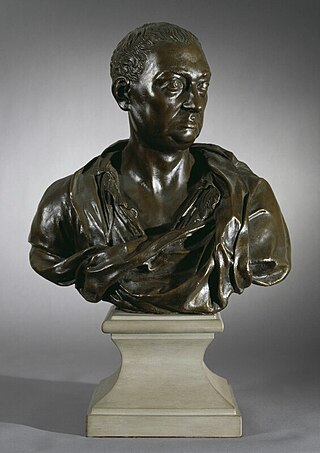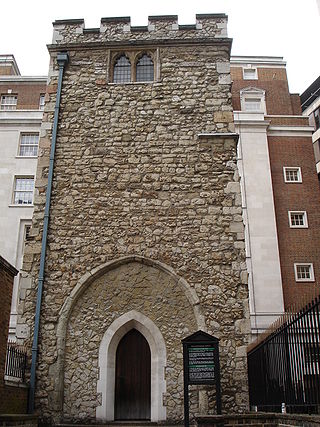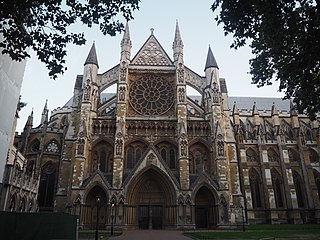
Nicholas Hawksmoor was an English architect. He was a leading figure of the English Baroque style of architecture in the late-seventeenth and early-eighteenth centuries. Hawksmoor worked alongside the principal architects of the time, Christopher Wren and John Vanbrugh, and contributed to the design of some of the most notable buildings of the period, including St Paul's Cathedral, Wren's City of London churches, Greenwich Hospital, Blenheim Palace and Castle Howard. Part of his work has been correctly attributed to him only relatively recently, and his influence has reached several poets and authors of the twentieth century.

St Martin-in-the-Fields is a Church of England parish church at the north-east corner of Trafalgar Square in the City of Westminster, London. Dedicated to Saint Martin of Tours, there has been a church on the site since at least the medieval period. This location, at that time, was farmlands and fields beyond the London wall.

St John's Smith Square is a redundant church in the centre of Smith Square, Westminster, London. Sold to a charitable trust as a ruin following firebombing in the Second World War, it was restored as a concert hall.

All Hallows Staining was a Church of England church located at the junction of Mark Lane and Dunster Court in the north-eastern corner of Langbourn ward in the City of London, England, close to Fenchurch Street railway station. All that remains of the church is the tower, built around AD 1320 as part of the second church on the site. Use of the grounds around the church is the subject of the Allhallows Staining Church Act 2010.

Sir Gilbert Heathcote, 1st Baronet was an English merchant and Whig politician who sat in the English and British House of Commons between 1701 and 1733. He also served as the governor of the Bank of England and was Lord Mayor of London in 1711.

A protected view or protected vista is the legal requirement within urban planning to preserve the view of a specific place or historic building from another location. The effect of a protected view is to limit the height of new buildings within or adjacent to the sightline between the two places so as to preserve the ability to see the landmark as a focus of the view. The protection may also cover the area behind the place or building concerned.

Thomas Archer (1668–1743) was an English Baroque architect. His buildings are important as the only ones by an English Baroque architect to show evidence of study of contemporary continental, namely Italian, architecture.
The year 1711 in architecture involved some significant events.
The Commission for Building Fifty New Churches was an organisation set up by Act of Parliament in England in 1711, the New Churches in London and Westminster Act 1710, with the purpose of building fifty new churches for the rapidly growing conurbation of London. It did not achieve its target, but did build a number of churches, which would become known as the Queen Anne Churches.

St Martin Outwich was a parish church in the City of London, on the corner of Threadneedle Street and Bishopsgate. Of medieval origin, it was rebuilt at the end of the 18th century and demolished in 1874.

Edward Stanton (1681–1734) was an English stonemason, builder and sculptor.
Events from the year 1711 in Great Britain.

St George Hanover Square was a civil parish in the metropolitan area of Westminster, Middlesex, later Greater London, England. The creation of the parish accompanied the building of the Church of St George's, Hanover Square, constructed by the Commission for Building Fifty New Churches to meet the demands of the growing population. The parish was formed in 1724 from part of the ancient parish of St Martin in the Fields in the Liberty of Westminster and county of Middlesex. It included some of the most fashionable areas of the West End, including Belgravia and Mayfair. Civil parish administration, known as a select vestry, was dominated by members of the British nobility until the parish adopted the Vestries Act 1831. The vestry was reformed again in 1855 by the Metropolis Management Act. In 1889 the parish became part of the County of London and the vestry was abolished in 1900, replaced by Westminster City Council. The parish continued to have nominal existence until 1922. As created, it was a parish for both church and civil purposes, but the boundaries of the ecclesiastical parish were adjusted in 1830, 1835 and 1865.

Francis Gastrell was Bishop of Chester and a writer on deism. He was a friend of Jonathan Swift, mentioned several times in A Journal to Stella, and chaplain to Robert Harley, 1st Earl of Oxford and Earl Mortimer, when Harley was Speaker of the House of Commons.

Westminster St James was a civil parish in the metropolitan area of London, England. The creation of the parish followed the building of the Church of St James, Piccadilly, in 1684. After several failed attempts, the parish was formed in 1685 from part of the ancient parish of St Martin in the Fields in the Liberty of Westminster and county of Middlesex. It included part of the West End of London, taking in sections of Soho, Mayfair and St James's. Civil parish administration was in the hands of a select vestry until the parish adopted the Vestries Act 1831. The vestry was reformed again in 1855 by the Metropolis Management Act. In 1889 the parish became part of the County of London and the vestry was abolished in 1900, replaced by Westminster City Council. The parish continued to have nominal existence until 1922.

St Margaret was an ancient parish in the City and Liberty of Westminster and the county of Middlesex. It included the core of modern Westminster, including the Palace of Westminster and the area around, but not including Westminster Abbey. It was divided into St Margaret's and St John's in 1727, to coincide with the building of the Church of St John the Evangelist, constructed by the Commission for Building Fifty New Churches in Smith Square to meet the demands of the growing population, but there continued to be a single vestry for the parishes of St Margaret and St John. This was reformed in 1855 by the Metropolis Management Act, and the two parishes formed the Westminster District until 1887. St Margaret and St John became part of the County of London in 1889. The vestry was abolished in 1900, to be replaced by Westminster City Council, but St Margaret and St John continued to have a nominal existence until 1922.
John Pulteney, of St James's, Westminster and Harefield, Middlesex, was an English lawyer and Whig politician who sat in the English and British House of Commons from 1695 to 1710.

St Anselm's Church in Southall is a Roman Catholic parish church served by the Society of Jesus in the London Borough of Ealing within the administration of the Archdiocese of Westminster. It is situated on The Green, a main thoroughfare into Southall. The parish was home to the De Nobili Dialogue Centre; a Jesuit building for inter-religious dialogue. It is also the only Catholic church in Southall and the parish has more than fifty nationalities represented in the congregation.

The 3rd Parliament of Great Britain was summoned by Queen Anne on 27 September 1710 and assembled on the 25 November 1710. Under the Triennial Act, the Parliament was due to expire, if not dissolved sooner, at the end of the term of three years from the first meeting. In the event it was actually dissolved on 8 August 1713.
















